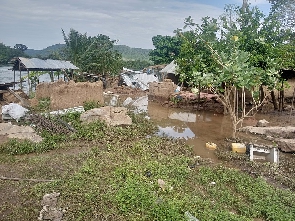The recent spillage of the Akosombo Dam has sent shockwaves through many communities in the Volta Region of Ghana. The devastating floods have not only disrupted lives but also wreaked havoc on infrastructure and claimed human casualties.
In the face of such a disaster, understanding the scale of loss and damage is paramount. This is where a well-developed comprehensive system for collecting data on flood impacts proves to be an invaluable tool.
The Akosombo Dam Spillage: A crisis unfolds:
The Akosombo Dam, located on the Volta River, is an essential component of Ghana's infrastructure, providing hydroelectric power and water management for the nation. However, when the dam reaches capacity and spillage becomes necessary, it poses a significant threat to the communities downstream. In recent days, such spillages have triggered severe flooding, displacing residents, causing infrastructure damage, and, tragically, leading to the loss
of human lives.
The need for comprehensive data collection:
When disaster strikes, understanding the scale of the impact is a crucial first step in the recovery process. This is where comprehensive data collection plays an indispensable role. By systematically gathering information on flood impacts, we can paint a clearer picture of the devastation caused by the Akosombo Dam spillage and, in turn, develop strategies to mitigate future occurrences.
What data is collected?:
A comprehensive data collection system for flood impact assessment encompasses three key areas:
Infrastructure damage: This involves surveying the damage to roads, bridges, homes, schools, and other vital structures. By collecting data on infrastructure destruction, we can assess the financial cost of rebuilding and identify areas in need of immediate attention.
Loss of livelihoods: This aspect of data collection aims to understand how the spillage affects local economies. Farmers, traders, and businesses often suffer when their livelihoods are disrupted by flooding. Documenting such losses helps authorities allocate resources for recovery and provides a basis for financial compensation to affected individuals.
Human casualties: Perhaps the most heart-wrenching aspect of any flood disaster is the loss of human lives. Collecting data on casualties is essential for honoring the victims and improving public safety measures. Understanding the number and circumstances of casualties also allows for better planning and risk reduction in the future.
The bigger picture: Understanding the scale of loss and damage:
Data collected through this comprehensive system provides a holistic view of the disaster's magnitude. It helps in answering critical questions, such as:
How many homes were damaged, and to what extent?
How many people were displaced, and what support did they need?
What is the human cost of the disaster in terms of casualties and injuries?
What economic losses have communities suffered, and how can they recover?
The answers to these questions enable authorities, NGOs, and local communities to formulate effective strategies for disaster management and preparedness,
reducing the vulnerabilities exposed by the spillage of the Akosombo Dam.
The path forward: Informed decision-making and resilience:
A comprehensive data collection system for flood impacts doesn't just serve as a tool for assessing loss and damage; it becomes a foundation for informed decision-making. It empowers governments, disaster management agencies, and local communities to plan for more resilient infrastructures, implement better flood control measures, and improve disaster preparedness.
In conclusion, the recent spillage of the Akosombo Dam has highlighted the pressing need for comprehensive flood impact assessment and data collection. Understanding the scale of loss and damage is the first step toward building a safer, more resilient future for the communities affected.
As the waters recede, we are left with the hope that this data will serve as a crucial catalyst for positive change and the mitigation of future disasters in the Volta Region.
Opinions of Wednesday, 18 October 2023
Columnist: Cedric Dzelu















